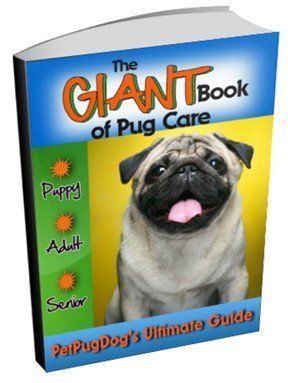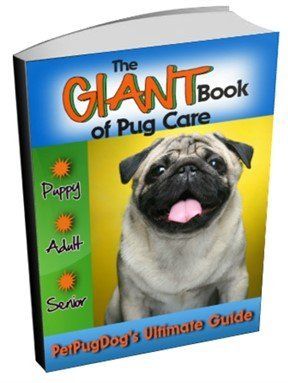Tails

Pug Tails
Overview
The Pug breed is unique in many ways and one of those is his tail. It is very distinct and its shape and curling is rarely seen in other breeds.
This breed has what is known as a 'corkscrew' or 'screw' tail.
In this section, we are going to go over details about a Pug dog's tail, including:
- At what age a Pug puppy starts wagging his tail
- Different types of Pug dog tails
- What it means if the tail uncurls
- Limp tail- a particular type of injury
Wagging
We received an email from an owner who was worried about her puppy:
Question:
"Do Pugs wag their tail? My Pug gets only a little movement. It is down a lot, so I am wondering if they can or do wag their tail?"
Answer:
You bring up a very good question, regarding the Pug tail. First of all, we do not know how old your Pug puppy is, however most dogs do not begin wagging their tail until they are about 7 weeks old.
If your Pug dog is still a puppy, under 7 weeks old, your dog should begin wagging the tail soon and there is nothing to worry about.
If your dog is much older than 7 weeks, we do suggest having your dog looked at. Tail wagging is a very important means of communication for a dog; though this breed is limited to an extent by how the tail is set high and the cartilage is curved.
The tail serves other purposes as well, such as providing a dog with balance and helping dogs to swim. A Pug uses his tail to express emotions and feelings even if it does not swing back and forth with wide arching oscillation that is seen with dogs that have long, loose tails.

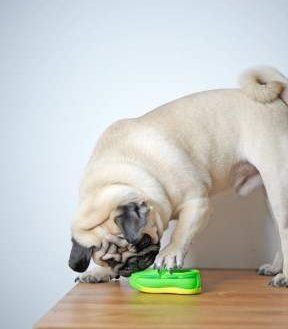
Tommy (meets the breed standard of a single curled tail)
Photo courtesy of owner: Srinivas from Dubai, UAE
Therefore, if there is a health problem that is preventing your Pug from moving his tail, it is important to find out what is wrong and see if it can be corrected. (more ahead)
What type of tail should a Pug dog have?
Breed standards call out for a curled tail. While the amount of curling will vary from dog to dog and can improve as a Pug matures, this is a defining physical feature.
The breed standards regarding the Pug's tail from all major organizations in the world are as follows:
AKC (American Kennel Club) and CKC (Canadian Kennel Club):
The tail is curled as tightly as possible over the hip. The double curl is perfection.
KC (The Kennel Club of the UK), FCI (Fédération Cynologique Internationale - Largest breed registry in the world with 80+ member countries) and ANKC (Australian National Kennel Council):
High-set, tightly curled over hip. Double curl highly desirable.
As you can see, both descriptions are very similar. In essence, the tail should curl tightly and if the tail has a double curl, this is judged as more favorable in the show ring. Most Pugs have a tail that not only curls, but lies over the back. This is an element of the breed standard and is the desired look. With this said, there are some Pugs that have a loose tail. We'll dive into this ahead.
Do All Pugs have curly tails?
Since the tail is a bone and cartilage appendage of the spine, the physical trait of it curling is due to a deviation in the spine in which the vertebrae is wedged-shaped, causing the tail to curl when held naturally.
This trait has been bred into the breed for thousands of years and is an extension of the spine. Therefore, just about all Pugs do have a curly tail. There are some Pugs that have a loose tail. This may be the case for one of several reasons:
1)
All Pugs may uncurl the tail at one time or another; some do this much more often and for young puppies it may happen a lot. The tail may tighten up during the maturity and growth
stage.
2)
There may be injury to the tail (more ahead)
3)
In some cases, it may be a matter of poor breeding practices. Some breeders focus very much on the tail, trying to achieve the very desirable 'double curl'; this makes for a strong, curled tail even if the double spiral is not achieved. If two Pugs with weak, looser tails are paired this can produce a litter in which those puppies have little curling. The dog is still able to be registered and so forth yet since it is not the preferred look of the breed, this is considered a major fault in the show ring.
Let's take a look at different types of tails that a Pug can have:
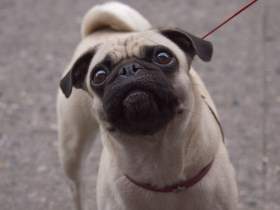
This young adolescent Pug puppy has a loose tail that is flipped over his back. This is a sign of a weak tail set but is not uncommon with pet (non-show) Pugs. As this pup matures, the tail may tighten up and have a curl. A double curled tail is not possible with this Pug; that sort of trait would be seen at a young age.
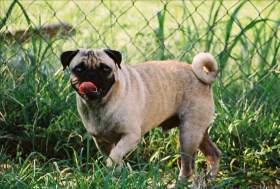
A nice curled tail. This is the type of tail you will most often see with a Pug dog. It will naturally lift over the back and have one curl in which the tail swirls over itself in one solidly held loop.
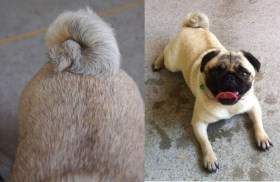
Photo of Ruby, courtesy of owner Alf Dixon of Australia
This Pug just officially has a nice, double curled tail. As you can see it has one large curl and then the end of the tail swirls over once more and it is held tightly. Some double tails make two complete circles of the same length.
This swirly feature is not all that common and is considered to be highly desirable in all major kennel organization show rings. No worries if your Pug does not have a double curl, it's not overly prevalent. How many Pugs have two double curls? Approximately 25% of all registered purebreds. Two complete loops is the exception, not the norm.
Is it normal for a Pug's tail to uncurl?
Sometimes a Pug's tail will become uncurled. This happens most often with puppies but it can happen with older Pugs as well.
It can happen when a puppy sleeps and the body is very relaxed or when a Pug knows that he did something wrong (had an accident, chewed up your shoes) and is reacting to the shame he feels.
With some, the tail will curl and uncurl all throughout the day.
This is not uncommon and for most Pugs, the tail will tighten up and stay curled as a puppy matures into an adult.
What does it mean if the tail suddenly goes limp?
If a Pug with a normally curled tail suddenly has a much looser tail this may be a sign that the dog is ill.
Other signs may be that the dog is extra tired, wanting to retreat, a sudden decrease in appetite, etc. This should be brought to the attention of the veterinarian.
This may also be a matter of a condition called "limp tail", which means that the bone at the base has been injured in some way, causing it to hang and not able to be moved by the dog or the dog resists moving it as doing so causing pain.
This is usually diagnosed by a veterinarian by taking x-rays.
Anti-inflammatory medications, pain medication and bed rest often result in normal use after a while.
What does it mean if a Pug holds his tail down or off to a funny angle?
While injury to the tail should be investigated, if a Pug holds his tail at a weird angle, the most common reason would be enlarged anal glands that need to be expressed.
This is best done by a vet or groomer, especially if the glands have been engorged for a long time. This can be exceedingly uncomfortable for a dog; the swelling and discomfort can cause a Pug's tail to drop or to be held in an odd way.
PetPugDog.com Copyright 2019. All rights reserved. Privacy Policy
We are a participant in the Amazon Services LLC Associates Program, an affiliate advertising program designed to provide a means for us to earn fees by linking to Amazon.com and affiliated sites.

